I ended last week’s Decapitating Louie series installment by saying, “I have a few more weeks to put more miles on the rebuilt head, adjust the valves again, and beat down any gremlins trying to crawl out from their dark places. But I’m feeling pretty good about [driving to] MidAmerica 02Fest. Maybe I’ll even paint those damned red hoses.”
I was referring to the red urethane hoses on the ends of the Top End Performance intake plenums These are the pieces that I literally pressed into service in place of the original plastic tii intake plenums, which for the life of me I could not snap back in place on the intake manifold, despite heating them in boiling water and using a heat gun to soften them up.
It turns out I wasn’t kidding. The fact that the urethane hose ends were not only bright red, but were the highest point in the engine compartment and thus practically in my face whenever I opened the hood bugged the hell out of me. Even though it was just cosmetics, not function, I decided that they had to go.
Although I mentioned painting them, my assumption was that paint was unlikely to stick, and a quick web search verified this. The only thing that would look worse than red urethane hoses was black paint flaking off red urethane hoses.
My next thought was that I’d simply replace them, but both the cost and uncertainty over the size—finding something that would snap into place over the short intake-manifold necks as securely is worrisome—stayed my hand. The outer diameter of the plenums is two inches, and while I could find two-inch black urethane, the red urethane hoses seem to be closer to 1-7/8″, allowing them to stretch and snap over the stubby manifold ends. McMaster Carr has rubber coolant hose with a 1-7/8″ inner diameter, but with adding shipping, the cost topped $35. If you’re like me (and lord, I hope you’re not), you’re schizophrenic about cost, spending money like water on certain things and pinching pennies on others. Spending$35 to change perfectly functional red hoses to black wandered across a line I didn’t know I had.
Then I had an idea: heat-shrink tubing.
Yes! I could simply cover the existing red hoses with black heat-shrink tubing! I found a vendor on eBay that sells an eighteen-inch length of 2.4″ tube for under seven bucks,. I cut it into eight pieces, and it worked perfectly. When I pop open the hood, that red is no longer the first thing I see.
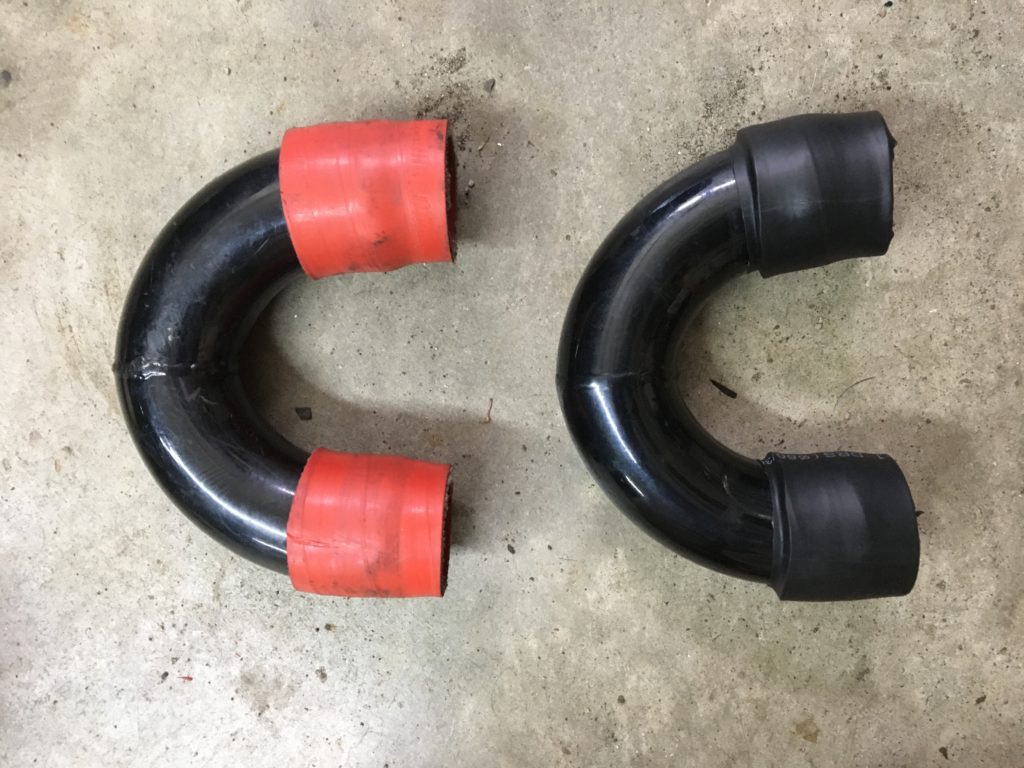
Here are the Top End Performance intake plenums before and after the application of the heat-shrink tubing.
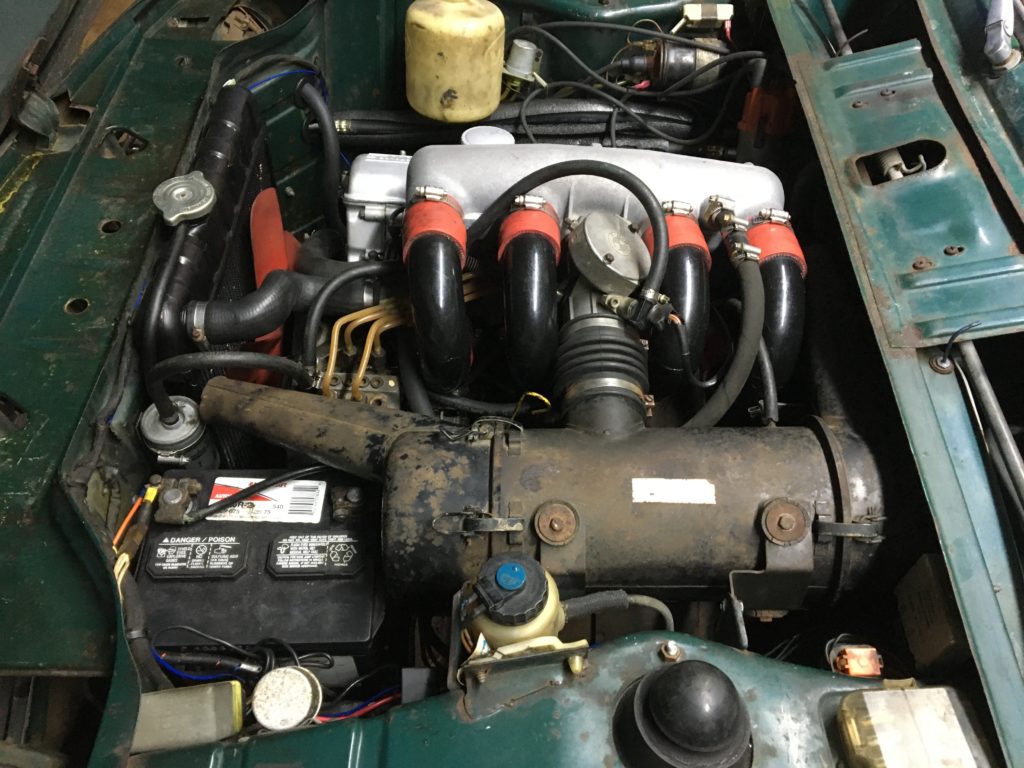
The engine compartment before…
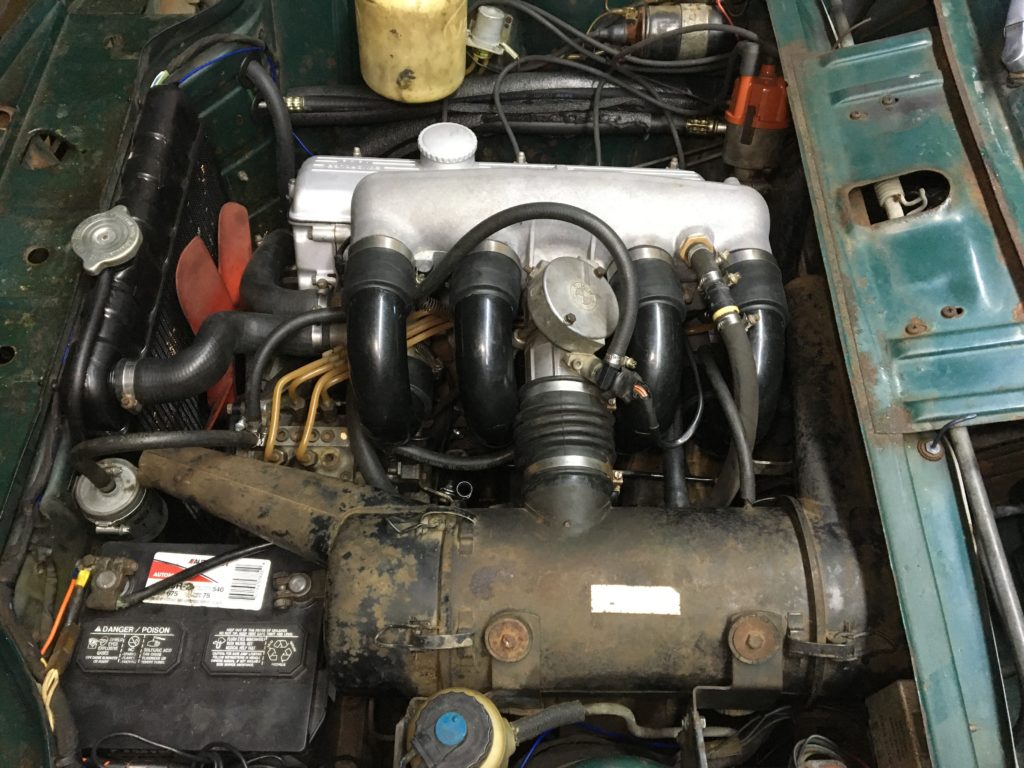
…and the engine compartment after. I feel so much better.
It was seven dollars ridiculously well spent.
Now I’ve put a little over 200 miles on Louie and adjusted the valves three times, but several of them still appear to be bedding in. As I said last week, that’s likely a consequence of my having replaced the rocker shafts but re-using the original valves and rockers. I hope to get 500 miles on the car before I leave for MidAmerica 02Fest on April 27, but really, any additional mileage needs to occur next week, since the week after that, my wife and I are going to Santa Fe, New Mexico, to see our middle son, Kyle, and I’ll be leaving for MidAmerica 02Fest the morning after we get back. I’ll probably wind up a doing valve adjustment before leaving the hotel at the midway point of the trip to MidAmerica, but it’s quick and easy enough to do.
The only other sorting-out point on Louie was an odd resonance that the car had at around 3,000 rpm. I prodded around in the engine compartment, and leaning on the recently-installed a/c compressor seemed to make it worse. I’ve had this happen before; in fact, on Kugel, my departed ’72 tii, the bolts holding the compressor bracket loosened themselves eight years ago on my last trip to MidAmerica, raising a hell of a resonant racket.
But the bolts on Louie’s compressor weren’t loose, and tightening them one arm-click short of a dying strain made no difference.
I crawled under the car while it was running and found that the source of the resonance: The exhaust pipe that passes above the rear subframe was close enough to actually make contact with it. Loosening the three bolts holding the resonator to the head pipe and rotating the entire rear exhaust section solved the acute part of the problem, but I’m still hearing something that feels a bit foreign to the character of the car. I guess there’s nothing like a long trip to either bed it into your consciousness as background noise or bring it to a head.
The other matter on the docket this week—the elephant in the driveway, so to speak—was dealing with the BMW population explosion at Chez Siegel. The four cars that were in Fitchburg (the Bavaria, the Euro 635CSi, Bertha the former track-rat 2002, and the M coupe) are all still here at the house. I would like to get them to their new home in the warehouse on the Mass-Connecticut border, but first, I’ve been busy with Louie; second, I wanted to take the opportunity to address some of the cars’ needs; and finally, I kind of like having them all here. Of course, the image of being able to hop into any one of them and drive it to buy milk and cereal on a Sunday morning doesn’t quite jibe with reality when the one you want to drive is buried five cars deep.
And then it rained.
Initially it was just a one-day event, but then the weather swung into a wet pattern that lasted nearly a week. I didn’t think that the cars’ short-term moisture exposure would bother me, but it did, especially for the Bavaria. So I reconfigured things, putting the Lotus Europa outside for a while and putting the Bavaria in the garage, where I could address some carburetor issues.
Of course, having the fragile Lucas-equipped Lotus out in the rain isn’t great, either, so I threw one of my generic ill-fitting covers over it. It blew off in short order. I used that as an opportunity to buy a real cover for the car, since these outdoor sits may become a necessary consequence of having more cars at the house, even if it’s not all of them.
A quick digression on car covers: I think I’ve only ever purchased one new cover, and that was the thin single-layer indoor cover for the E9 after I had the car painted almost 35 years ago. All of my other covers either came with cars I bought or were given to me by folks who had sold cars and found the cover in the garage, or were purchased used. When you buy an expensive, new $300-plus cover like a CoverCraft, what you’re paying for, in addition to it being largely waterproof and breathable and having a nice fleece lining, is that the thing is custom-designed to fit that car, which means that when the elastics on the front and rear are seated below the nose and tail, it’s a snug fit, free of billowing fabric that the wind can catch and tear off. The CoverCraft covers I have for the Z3 (purchased used) and the M coupe (came with the car) work absolutely flawlessly in this regard. Every other cover I’ve used outside, whether they’re supposedly made for the car or not, has blown off. I’m hesitant to use straps or bungies, as the one time I did, the rubbing created marks in the car’s paint—and what little paint is left on the Lotus is very fragile.
I covered the Euro 635CSi and Bertha the former track-rat 2002 and hoped for the best, then did a bit of looking online for a proper cover to the Lotus. CoverCraft doesn’t appear to offer a cover for a Europa, so I bought a five-layer “gold shield” cover from the Car Cover Company (carcover.com, not to be confused with carcovers.com; that’s someone else). Their 50% off sale plus a 15% coupon didn’t necessarily make me think that I was buying a $300 custom-fit cover for $127, but the price was right, and their website expressed a lot of pride in their covers’ correct fit.
Unfortunately, what arrived was an oversized, billowy mess, with fabric literally dragging on the cement on both sides of the car. It was so far from what I expected that I actually contacted the manufacturer. To their credit, they’re sending me another cover.

Left to right: The Z3, the 635CSi, Bertha, and the Lotus. They look like mushrooms growing in my driveway.
With the Bavaria occupying precious indoor space, I began addressing its punch list.

I like this garage. This is a happy garage—especially when it holds the Nixon-Era Triplets.
The Bavaria had two carburetor problems. The first was that the automatic choke on one of the Weber 32/36s was sticky, making starting and warmup harder than it needed to be. The second was that the car had an even-throttle hesitation that made it buffet slightly on the highway.
For the choke issue, I needed to pull the choke assembly off and disassemble it to find out where it was binding. This required pulling the carb off the car—at least it seemed to me that this was necessary to both access the choke housing screws as well as wrangle the thing off its little arm.
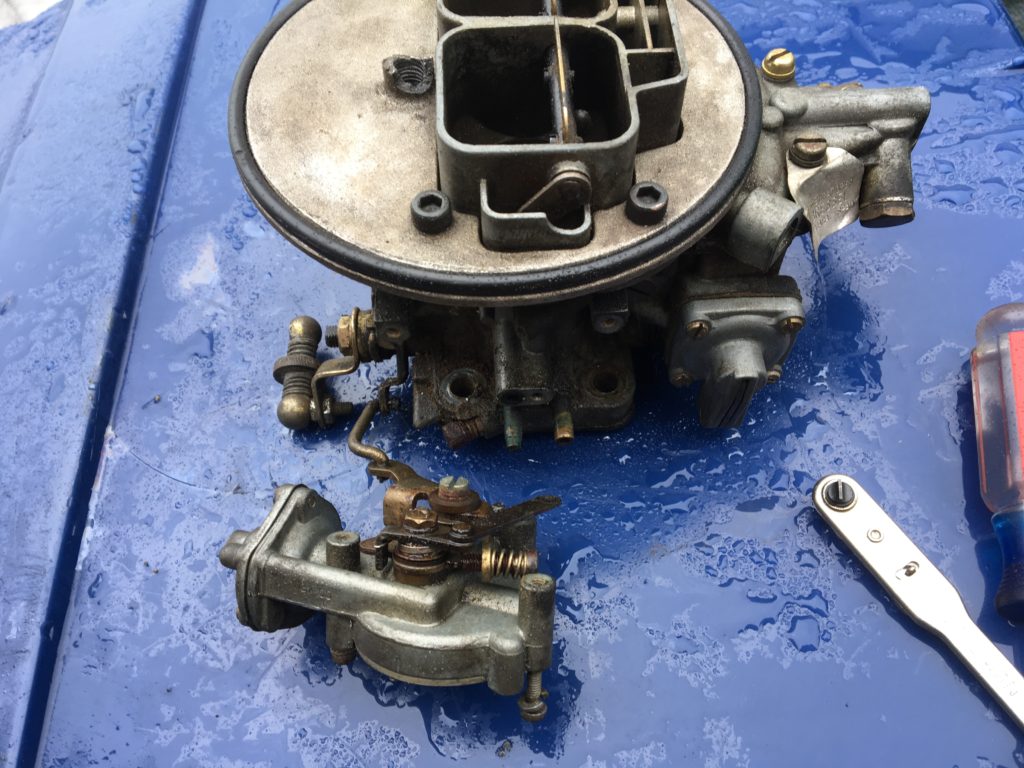
Pulling the sticky choke assembly off one of the Webers.
Upon pulling the choke assembly apart, I found that the cause was a very small washer with an oval hole in the middle: The washer had broken into pieces. If you own a car with a Weber or Webers and have not discovered Pierce Manifolds, you should. In a few days, I had the part and a choke that no longer stuck.
The even-throttle hesitation issue required me to check the synchronization of the Bavaria’s Webers. I have a Uni-Syn carb synchronizer, but to use it on Weber 32/36s, you need a pair of adapters to fit it to the top of each carb, above the open choke plates. My friend Paul Wegweiser loaned me his pair. The carb synchronization is now much better than it was, and the Bavaria no longer experiences constant-throttle hesitation at 70 mph highway speeds, but I can definitely still feel buffeting at 2,000 to 3,000 rpm, so I have not completely solved this problem. However, right now I just need to get the car running well enough to drive it out to the new storage area in Monson before I leave for MidAmerica 02Fest.
With the Bav running acceptably, I looked at the weather, looked at the calendar, and made the snap decision to run three of the cars out to their new home in Monson. I checked that the warehouse owner was available on Saturday, and roped Maire Anne and two friends into driving cars.
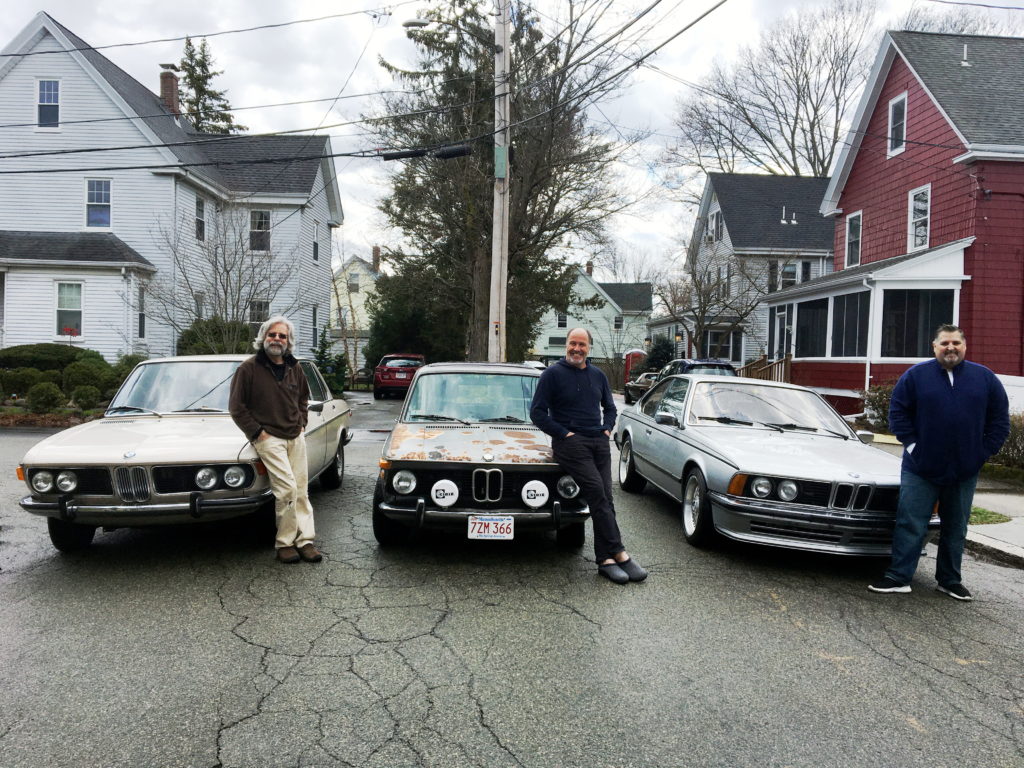
Left to right: me and friends Alex Wajsfelner and Bob Selfridge. [Photo courtesy Maire Anne Diamond.]
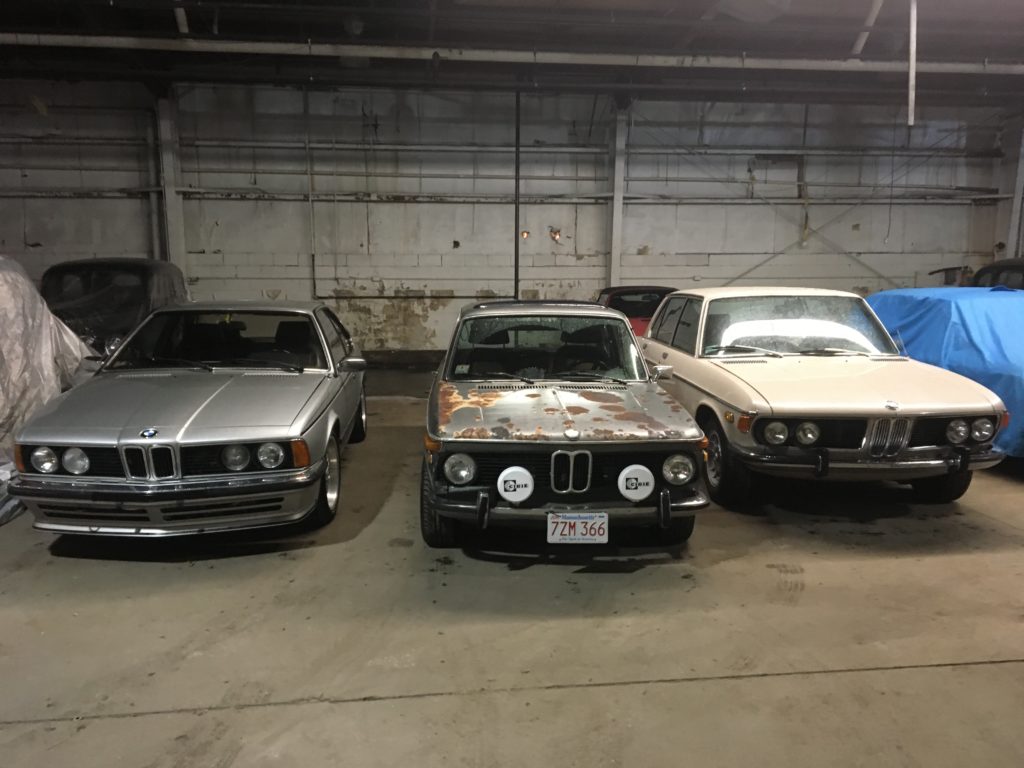
The three cars in the Monson warehouse next to Hampton (under the blue cover) which I moved out in late December.
All in all, I’d say it’s been not a bad week.—Rob Siegel
Rob’s new book, The Best of The Hack Mechanic, is available here on Amazon, as are his seven other books. Signed copies can be ordered directly from Rob here.





















